Study on Characteristics and Numerical Simulation of a Convective Low-Level Wind Shear Event at Xining Airport
Abstract
1. Introduction
2. Study Area and Data Collection
2.1. Introduction to Xining Airport
2.2. Instruments and Data Selection
2.3. Model Configuration
3. Synoptic Situation and Observations
3.1. Synoptic Background Analysis
3.2. Observation Analysis
3.3. Analysis of Radar Echoes
4. Analysis of the Structure and Evolution Characteristics of Wind Shear
4.1. Analysis of the Evolution Characteristics of the Horizontal Wind Field
4.2. Analysis of the Evolution Characteristics of the Vertical Wind Field
4.3. Characteristics of the Vertical Wind Field of the Convective System
4.4. Analysis of the Wind Field Characteristics from the Perspective of the Glide Path
5. WRF-LES Evaluation
5.1. Wind Field Simulation Performance at 10 m
5.2. Wind Profile Simulation Performance
6. Conclusions and Discussions
- (1)
- The synergistic use of multi-source observations enabled a refined depiction of the entire life cycle of wind shear generation, evolution, and dissipation. DWR revealed the synchronous relationship between rapid echo-top descent and surface wind acceleration, confirming the role of downdrafts during the dissipating stage of convective cells as the primary triggering mechanism. PPI and RHI scans captured the formation of the initial shear zone and the vertical shear layer near 700 m, while high-frequency AWOS measurements documented 5–6 m/s wind surges during the go-around phase, providing direct evidence for identifying critical risk periods.
- (2)
- DBS mode reconstructed the three-dimensional wind field from the surface to 3 km, showing a near-180° counterclockwise wind shift and vertical flow reversal induced by downdrafts, forming a typical shear structure. The GP mode further quantified the flight impacts at different stages: during the convective development phase, multiple headwind shears (maximum 12 m/s) caused landing points to shift rearward, while in the decaying phase, tailwind shear combined with crosswinds up to 20 m/s and alternating wind reversals led to yaw deviations, providing quantitative support for flight risk assessment.
- (3)
- Multi-source data jointly confirmed the enhancement effect of mesoscale convergence and divergence on shear intensity. As the convective cell shifted eastward, multiple radial velocity couplets appeared on the eastern runway side; at the go-around stage, two convergence bands overlapped, producing a peak shear intensity of 8 m/s/km. This structure was further corroborated by AWOS observations of wind speed differences between the western (11 m/s) and eastern (3 m/s) stations, delineating the spatial distribution of the highest-risk zone.
- (4)
- WRF-LES successfully reproduced the key dynamical characteristics of the event: the 10 m wind field accurately simulated the near-180° counterclockwise wind shift and two episodes of wind acceleration, while the vertical wind profiles reproduced alternating disturbances between 1 and 2.5 km (including a strong downdraft core) that matched well with DWL observations, validating its capability to simulate mesoscale dynamical processes in complex plateau terrain.
Author Contributions
Funding
Institutional Review Board Statement
Informed Consent Statement
Data Availability Statement
Acknowledgments
Conflicts of Interest
References
- Lin, C.; Zhang, K.; Chen, X.; Liang, S.; Wu, J.; Zhang, W. Overview of low-level wind shear characteristics over Chinese mainland. Atmosphere 2021, 12, 628. [Google Scholar] [CrossRef]
- Gultepe, I.; Agelin-Chaab, M.; Komar, J.; Elfstrom, G.; Boudala, F.; Zhou, B. A meteorological supersite for aviation and cold weather applications. Pure Appl. Geophys. 2019, 176, 1977–2015. [Google Scholar] [CrossRef]
- Cheng, X. Characteristics of Plateau Meteorology and Countermeasures for Aviation Meteorological Support. Guide Sci-Tech Mag. 2012, 28, 335. [Google Scholar]
- Krüs, H.W. Criteria for crosswind variations during approach and touchdown at airports. In Advances in Simulation of Wing and Nacelle Stall; Radespiel, R., Niehuis, R., Kroll, N., Behrends, K., Eds.; Springer International Publishing: Cham, Switzerland, 2016; pp. 167–187. [Google Scholar]
- Wang, S.J. Preliminary Analysis of Wind Shear at Xining Airport in Qinghai Province. Beijing Agric. 2013, 27, 137–138. [Google Scholar]
- Zhao, Z.J.; Cai, G.S. Statistics and Analysis of Low-level Wind Shear Weather Processes at Xi’an Xianyang International Airport. In Proceedings of the 2006 Annual Meeting of the China Meteorological Society, Chengdu, China, 25–27 October 2006. [Google Scholar]
- Hua, Z.Q.; Huang, X.; Zhao, Q.; Tian, W.; Sun, Y. Statistics on the Characteristics of Low-level Wind Shear at Xining Airport and a Preliminary Exploration of Early Warning Indicators. J. Civ. Aviat. 2024, 8, 99–103, 169. [Google Scholar]
- Shan, N.C.; Zhou, H.F.; Chen, S.Q.; Zhao, Q. Mechanism Analysis of a Low-level Wind Shear Event at Hefei Airport. Meteorol. Sci. Technol. 2018, 46, 1240–1250. [Google Scholar]
- Guo, Z.L.; Xie, W.F.; Zhong, J.J.; Li, W.B.; Chen, S.M. Analysis of a Low-level Wind Shear Process Caused by a Microburst at Guangzhou Baiyun Airport. Desert Oasis Meteorol. 2019, 13, 71–78. [Google Scholar]
- Lu, Y.; Chen, L.J. Analysis of the Action Mechanism of a Convective Low-level Wind Shear at Longnan Airport. J. Meteorol. Disaster Prev. 2023, 30, 34–39. [Google Scholar]
- Feng, L.T.; Zhou, J.; Fan, Q.; Chen, Y.X.; Liu, Z.P.; Lu, M.T.; Zhou, D.F.; Hou, T.J. Three-dimensional Wind Lidar for Wind Shear Detection and Early Warning at Civil Aviation Airports. Acta Photonica Sin. 2019, 48, 192–202. [Google Scholar]
- Li, L.; Shao, A.; Zhang, K.; Ding, N.; Chan, P.-W. Low-level wind shear characteristics and lidar-based alerting at Lanzhou Zhongchuan international airport, China. J. Meteorol. Res. 2020, 34, 633–645. [Google Scholar] [CrossRef]
- Han, Y.; Liu, J.; Sun, D.; Han, F.; Zhou, A.; Zhao, R.; Xue, X.; Chen, T.; Zhen, F.; Lu, Y. Fine gust front structure observed by coherent doppler lidar at Lanzhou airport (103°49′ E, 36°03′ N). Appl. Opt. 2020, 59, 2686. [Google Scholar] [CrossRef]
- Huang, X.; Zheng, J.F.; Zhang, J.; Ma, X.L.; Tian, W.D.; Hua, Z.Q. Study on the Structure and Characteristics of a Low-level Wind Shear Event at Xining Airport. Laser Technol. 2022, 46, 206–212. [Google Scholar]
- Zhang, T.; Li, Q.; Zheng, J.F.; Zhang, W.L.; Fan, Q.; Zhang, J. Study on Low-level Wind Shear Caused by Microburst Using Wind Lidar. Laser Technol. 2020, 44, 563–569. [Google Scholar]
- Chen, F.; Peng, H.; Chan, P.; Huang, Y.; Hon, K.K. Identification and analysis of terrain-induced low-level windshear at Hong Kong international airport based on WRF–LES combining method. Meteorol. Atmos. Phys. 2022, 134, 60. [Google Scholar] [CrossRef]
- Dzebre, D.E.K.; Adaramola, M.S. A preliminary sensitivity study of planetary boundary layer parameterisation schemes in the weather research and forecasting model to surface winds in coastal Ghana. Renew. Energy 2020, 146, 66–86. [Google Scholar] [CrossRef]
- Xing, W.W.; Sun, J.H.; Liu, H.Z.; Xu, L. Numerical Simulation of the Local Circulation of Complex Topography on the Gaoligong Mountains. Chin. J. Atmos. Sci. 2021, 45, 746–758. (In Chinese) [Google Scholar] [CrossRef]
- Doubrawa, P.; Montornès, A.; Barthelmie, R.J.; Pryor, S.C.; Casso, P. Analysis of different gray zone treatments in WRF-LES real case simulations. Wind. Energy Sci. Discuss. 2018, 2018, 1–23. [Google Scholar] [CrossRef]
- Li, Y.Q.; Shi, C.X.; Shen, R.P.; Li, Y.; Zhang, D.J.; Ge, L.L. Near-surface wind field simulation and boundary layer scheme sensitivity study in the Mentougou area based on WRF-LES. Plateau Meteorol. 2023, 42, 758–770. [Google Scholar]
- Liu, Y.J.; Miao, S.G.; Hu, F.; Liu, Y.B. Large-eddy simulation study of boundary layer wind field in the Xiaohaituo Mountain competition area of the Winter Olympics. Plateau Meteorol. 2018, 37, 1388–1401. [Google Scholar]
- Zhang, S.; Wang, Z.M.; Huang, G.; Xue, X.W. Local wind field simulation over complex terrain in Chongli based on WRF-LES. Plateau Meteorol. 2023, 42, 197–209. [Google Scholar]
- Zhou, B.; Simon, J.S.; Chow, F.K. The Convective Boundary Layer in the Terra Incognita. J. Atmos. Sci. 2014, 71, 2545–2563. [Google Scholar] [CrossRef]
- Noh, Y.; Cheon, G.W.; Hong, Y.S.; Raasch, S. Improvement of the K-profile Model for the Planetary Boundary Layer based on Large Eddy Simulation Data. Bound.-Layer Meteorol. 2003, 107, 401–427. [Google Scholar] [CrossRef]
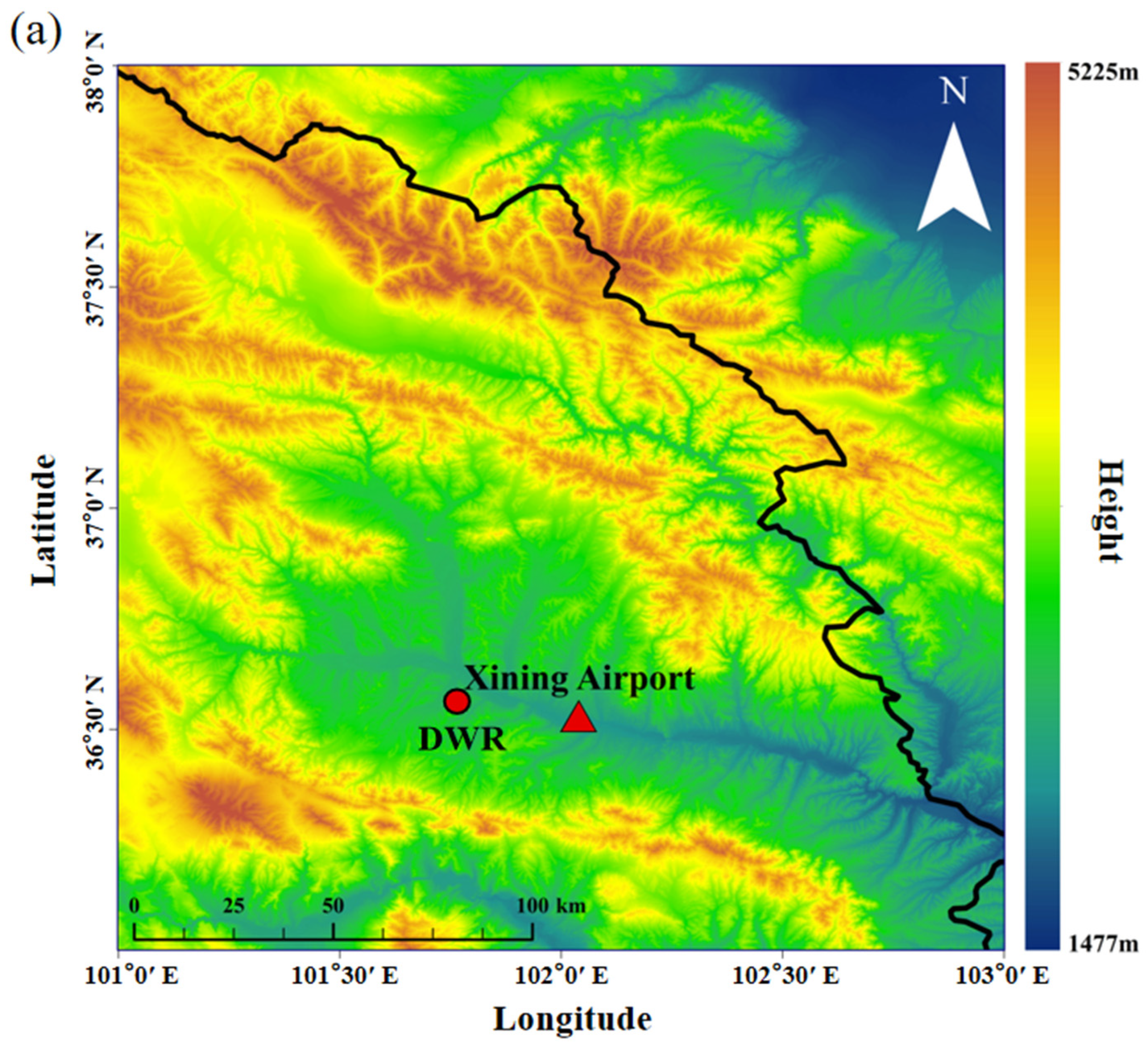
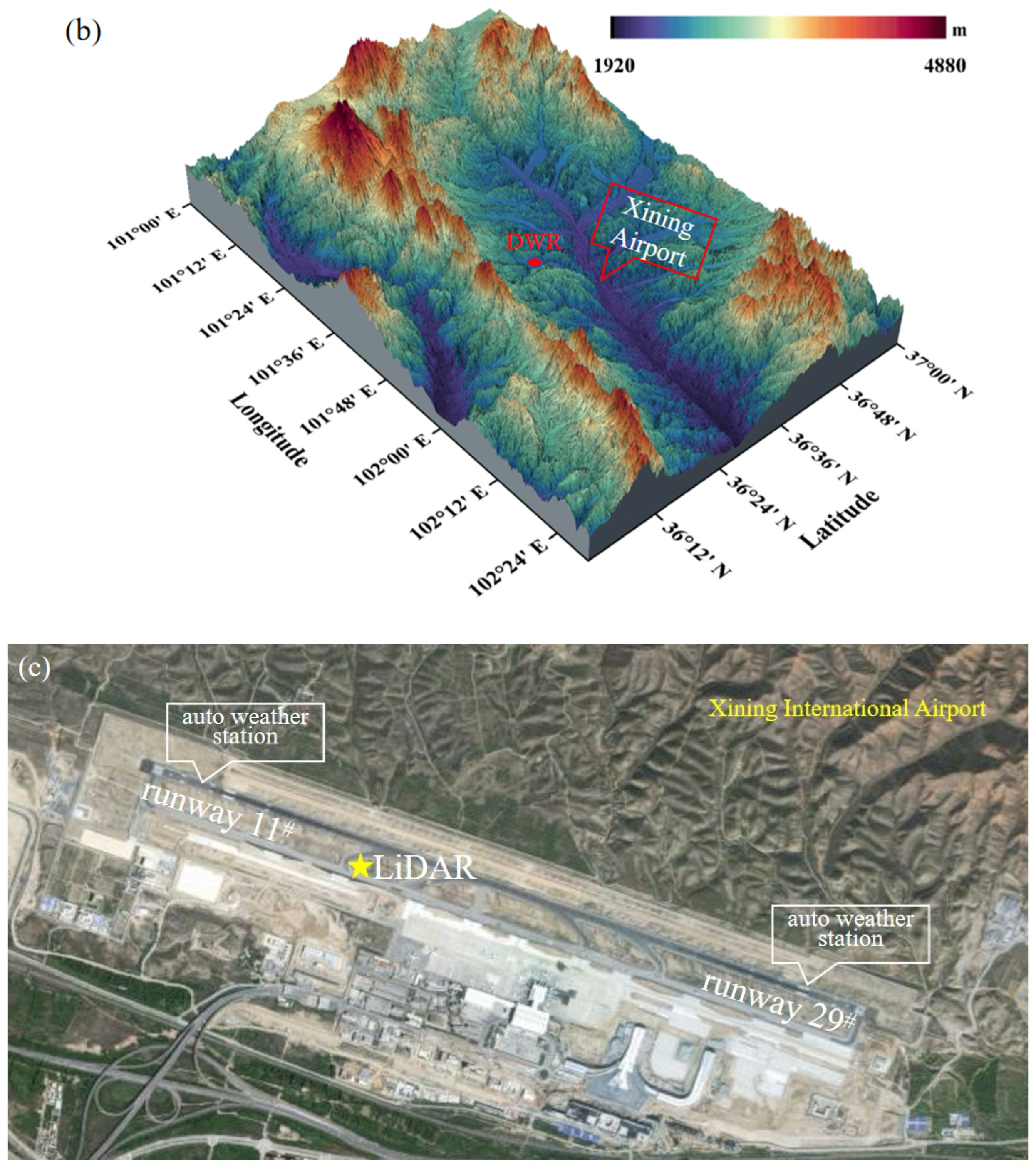


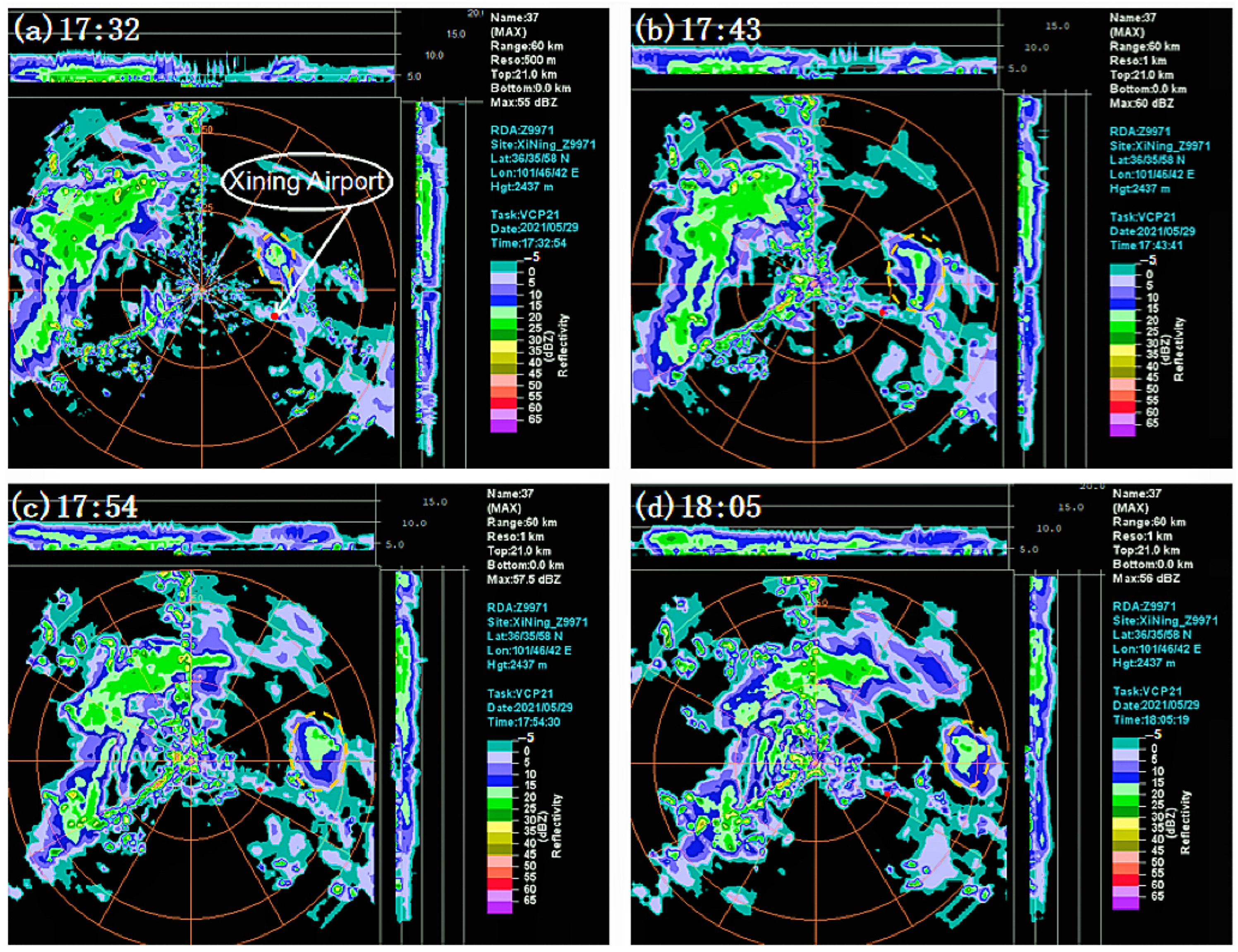
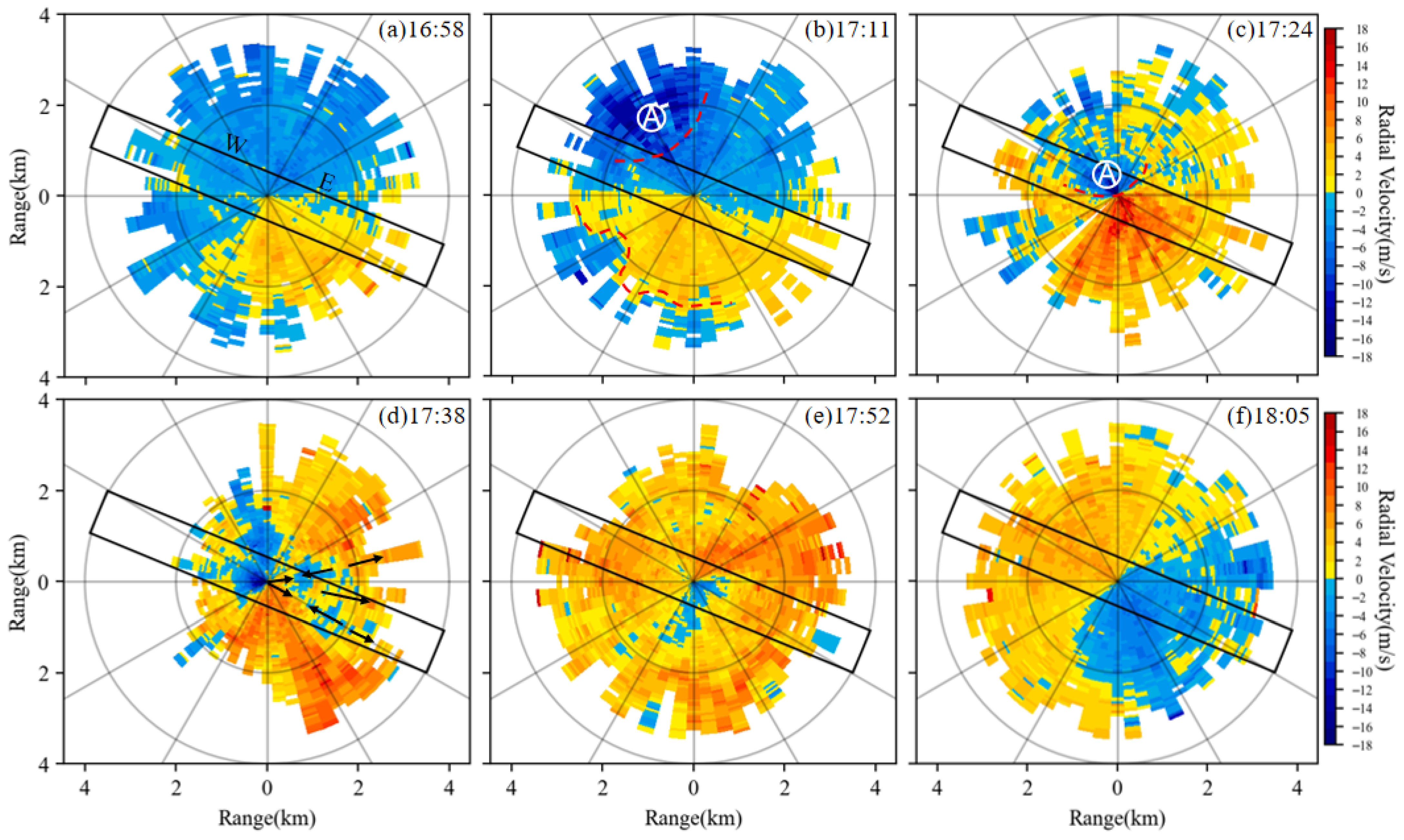
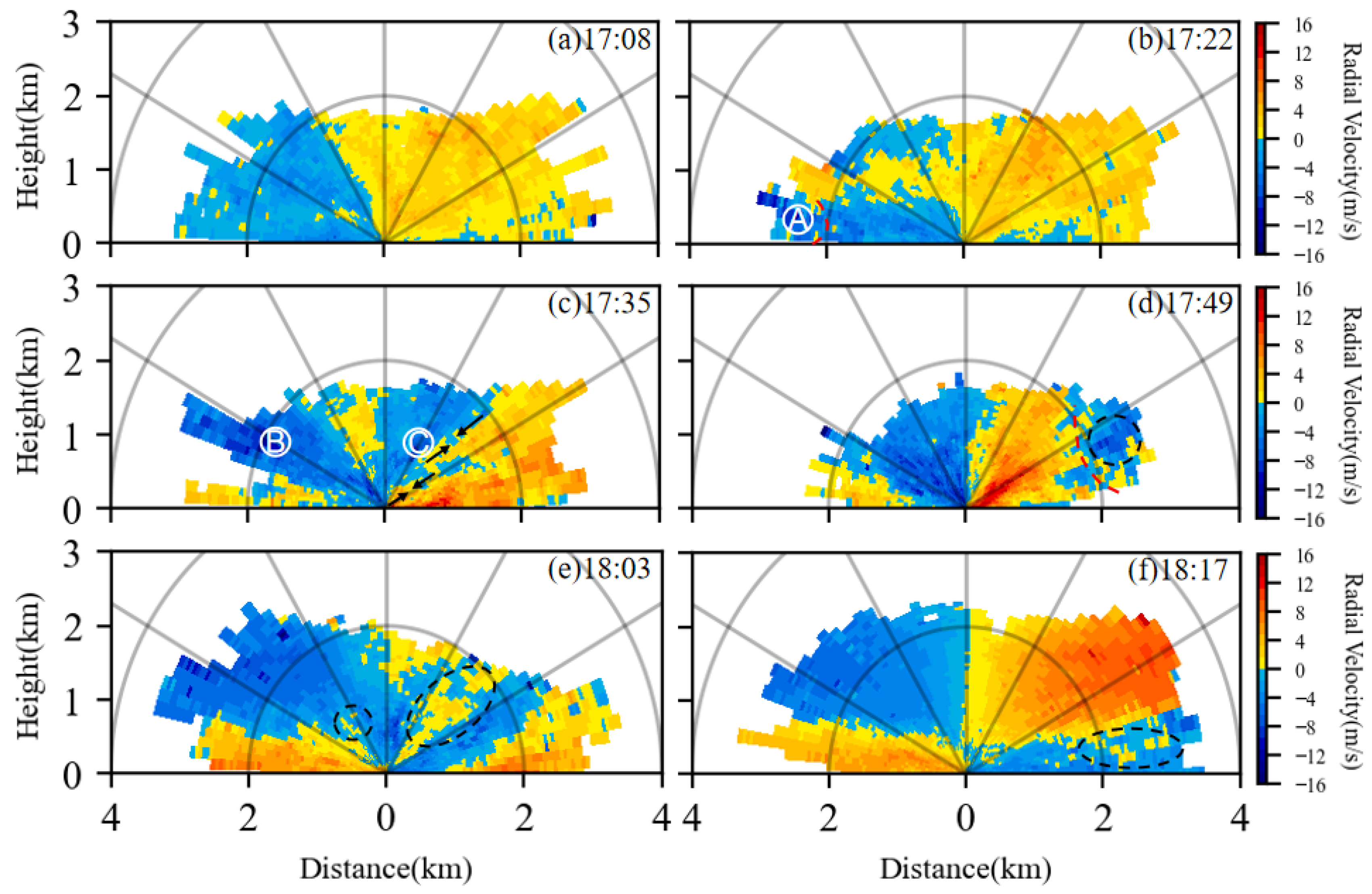
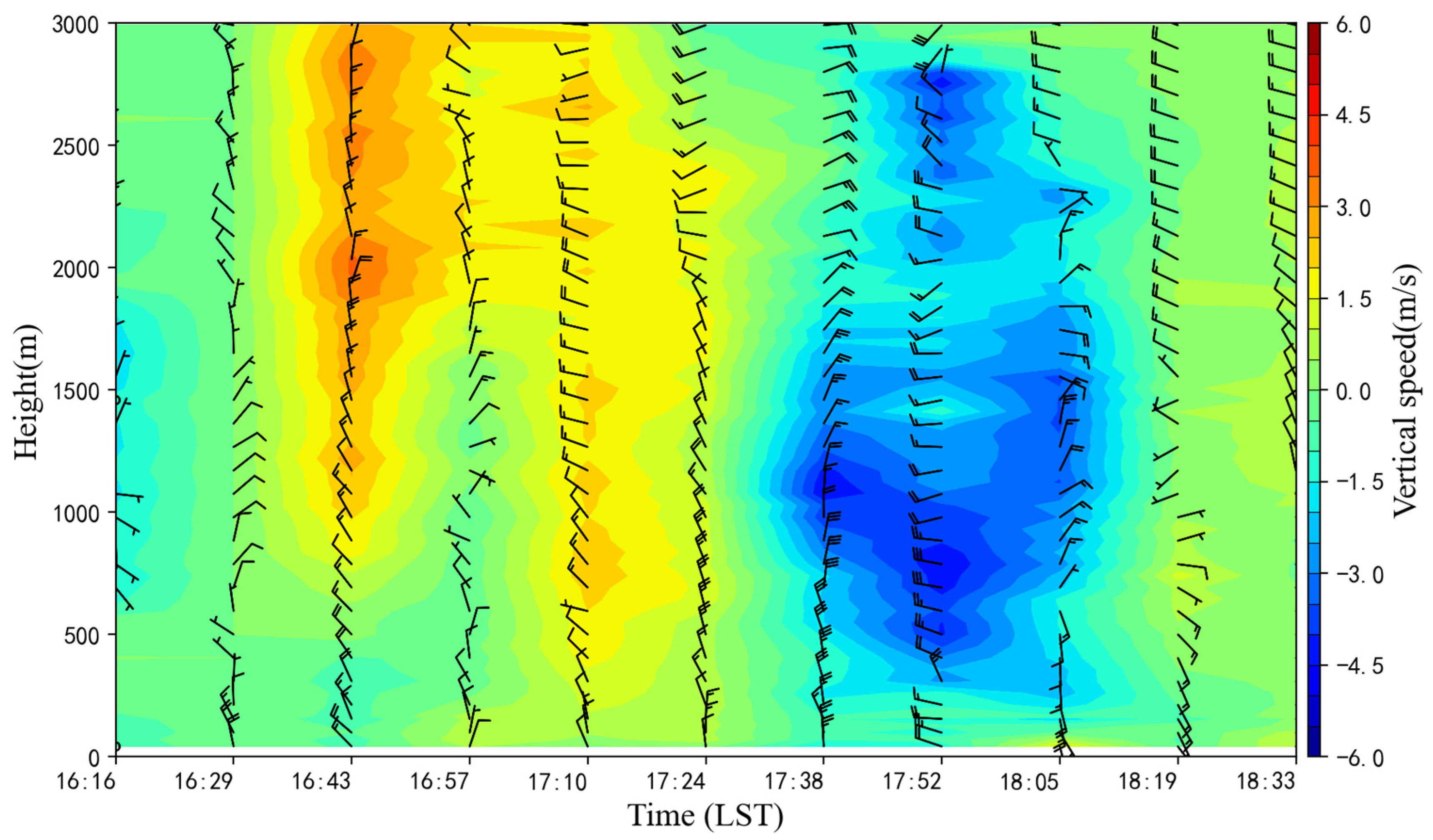
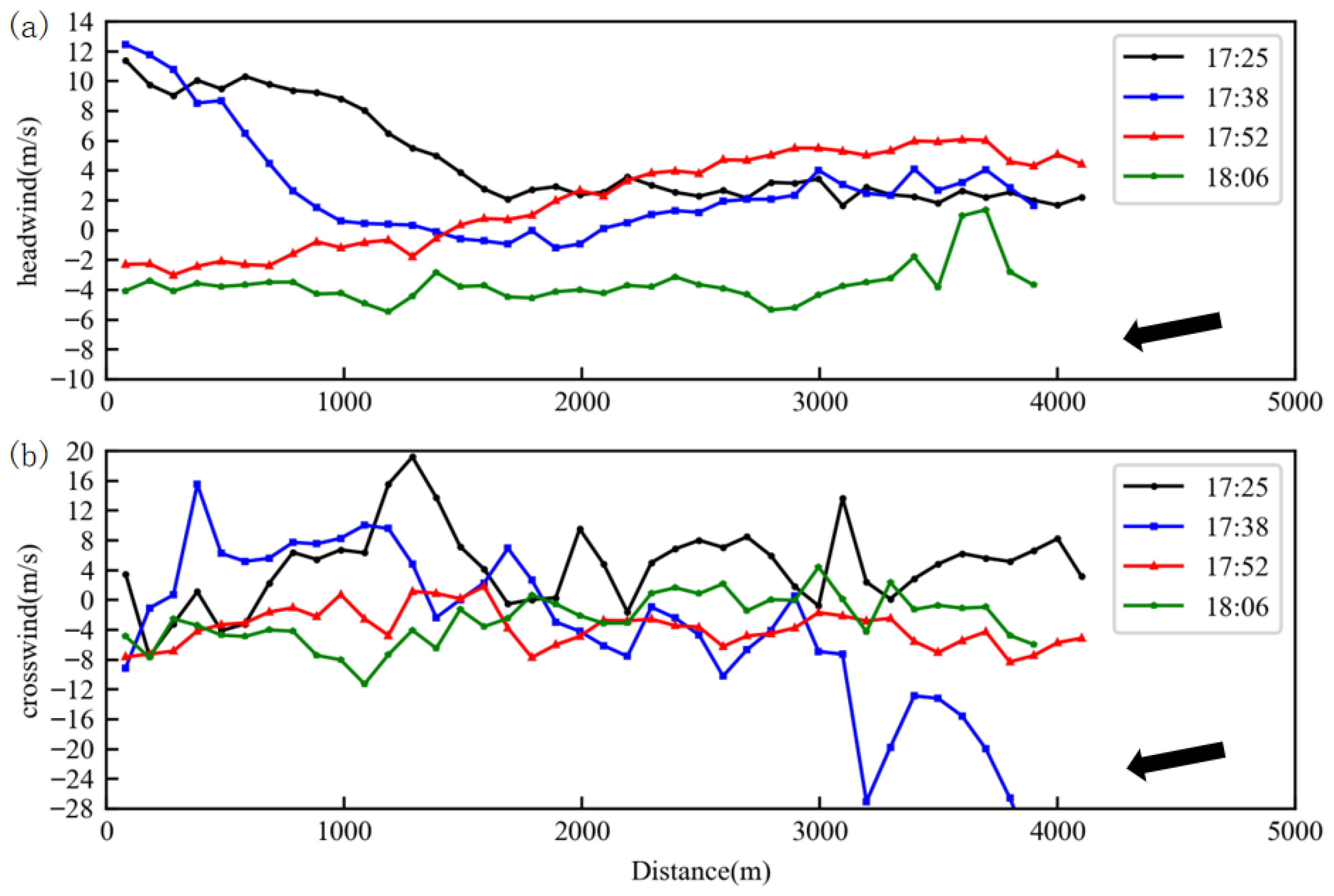
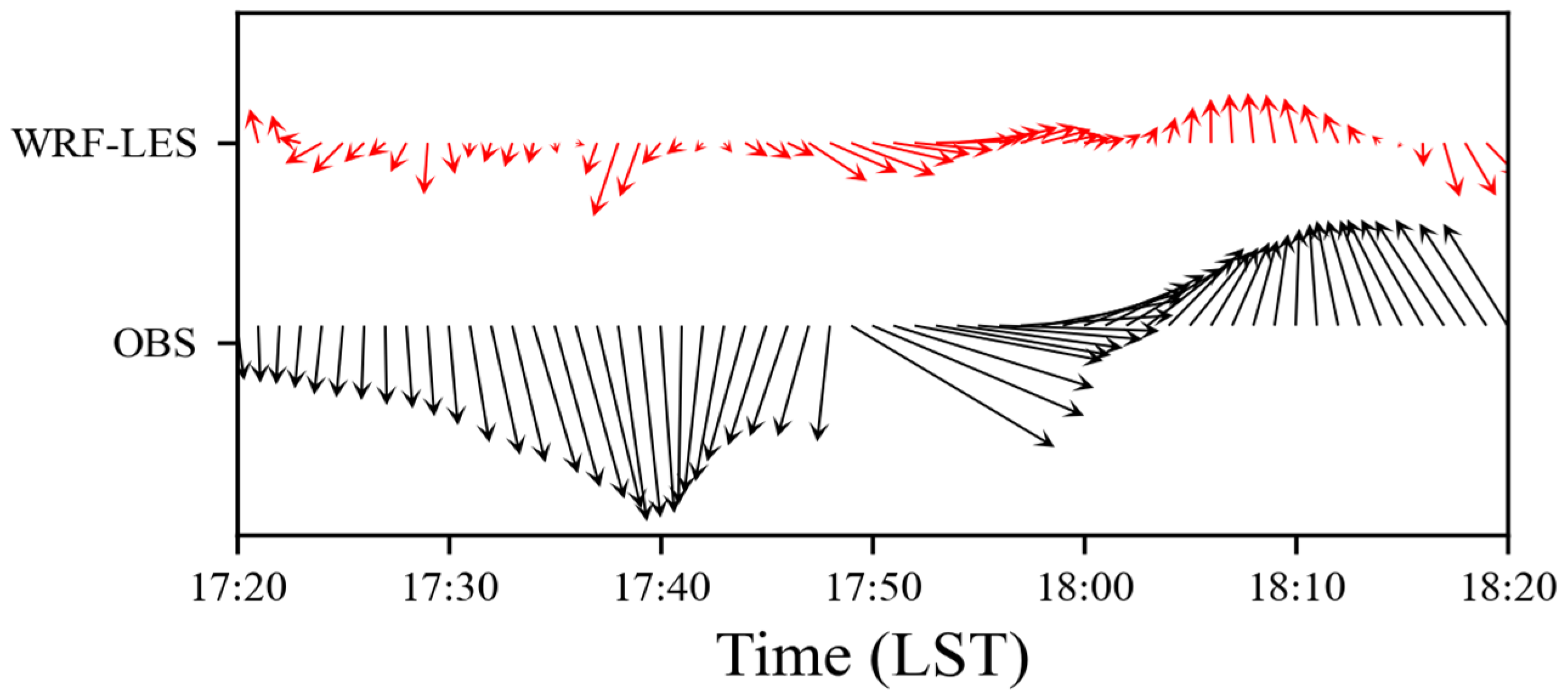
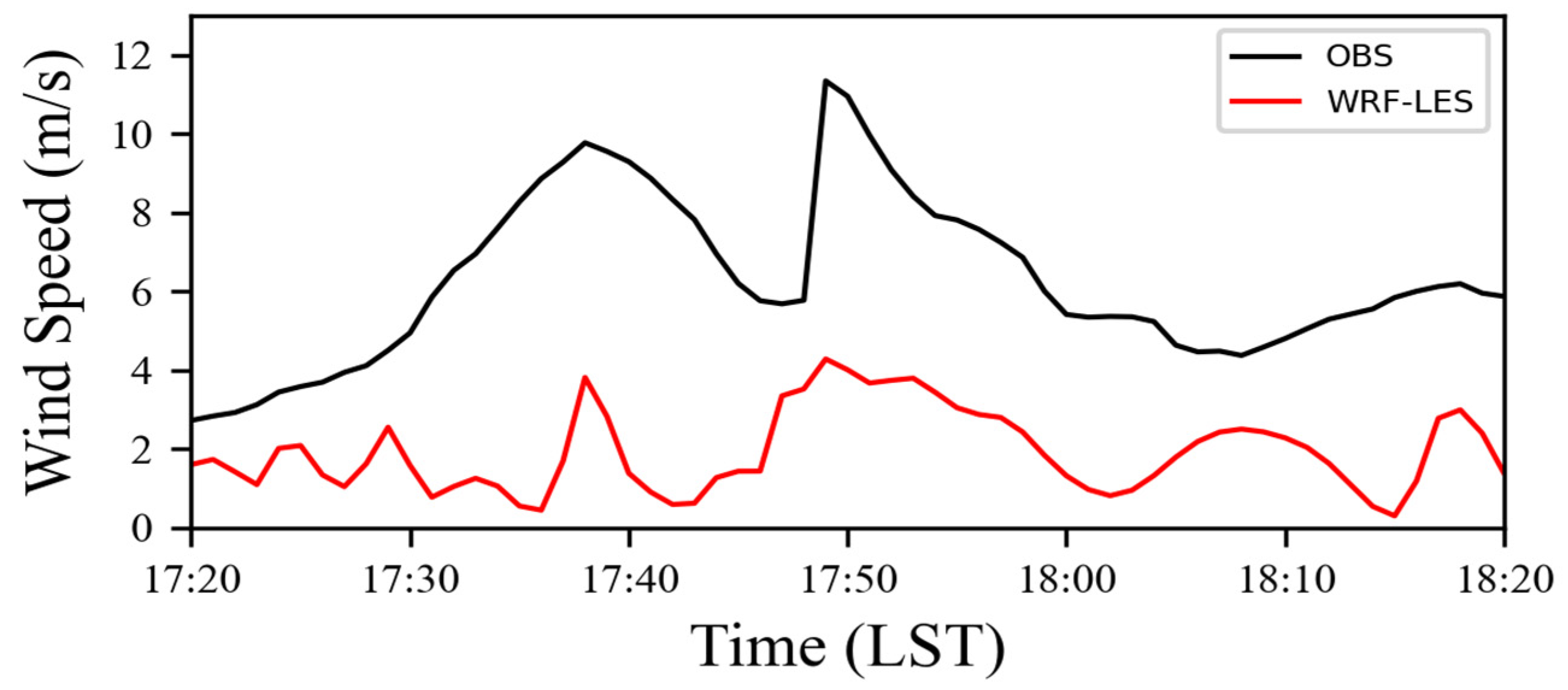
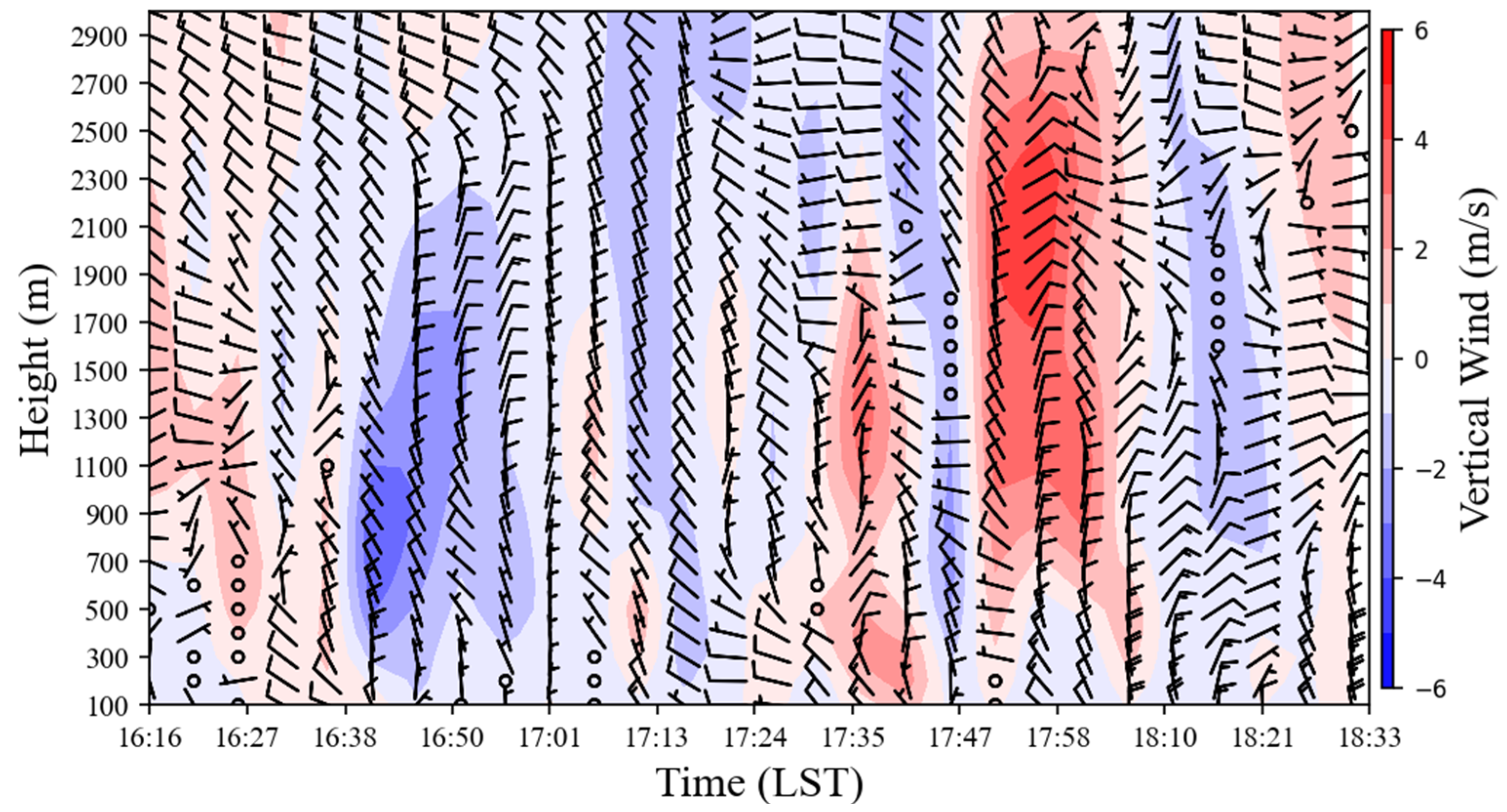
| Parameters | Value |
|---|---|
| Average power/W | ≤200 |
| Wavelength/nm | 1550 |
| Scan range (azimuth/pitch)/(°) | 0–360/0–90 |
| Detection range/km | 0.05–10 |
| Range resolution/m | 100 |
| Scanning mode | DBS/PPI/RHI/GP |
| Minimum time resolution/s | ≤2 |
| Elevation resolution/(°) | ≤0.1 |
| Wind speed range/(m·s−1) | −60–+60 |
| Wind velocity accuracy/(m·s−1) | ≤0.5 |
| Wind angle accuracy (profile mode)/(°) | ≤10 |
| Measurements | radial velocity, wind profile, vertical air motion, spectrum width, signal-to-noise ratio, etc. |
| Scheme/Parameter | Description |
|---|---|
| Terrain data | Default GTPO30 dataset |
| Map projection | Lambert |
| Simulation period | 29 May 2021 |
| Background meteorological data | . ERA5 reanalysis (temporal resolution: 1 h) |
| Domain center coordinates | 36.5° N, 102° E |
| Nested domains | 4 nested domains |
| Grid spacing | 7500 m; 1500 m; 300 m; 100 m |
| Number of grid points | , , , |
| Vertical levels | 60 |
| Microphysics | New Thompson graupel scheme |
| Longwave radiation | Rapid Radiative Transfer Model (RRTM) |
| Shortwave radiation | Rapid Radiative Transfer Model for GCMs (RRTMG) |
| Surface layer | Monin–Obukhov scheme |
| Planetary boundary layer | YSU scheme for d01 and d02 |
| Cumulus parameterization | Shallow convection Kain–Fritsch (new Eta) scheme for the outermost domain; none for others |
| Land surface | Noah land surface model |
Disclaimer/Publisher’s Note: The statements, opinions and data contained in all publications are solely those of the individual author(s) and contributor(s) and not of MDPI and/or the editor(s). MDPI and/or the editor(s) disclaim responsibility for any injury to people or property resulting from any ideas, methods, instructions or products referred to in the content. |
© 2025 by the authors. Licensee MDPI, Basel, Switzerland. This article is an open access article distributed under the terms and conditions of the Creative Commons Attribution (CC BY) license (https://creativecommons.org/licenses/by/4.0/).
Share and Cite
Gu, J.; Qiu, Y.; Zhang, S.; Yang, X.; Luo, S.; Zheng, J. Study on Characteristics and Numerical Simulation of a Convective Low-Level Wind Shear Event at Xining Airport. Atmosphere 2025, 16, 1137. https://doi.org/10.3390/atmos16101137
Gu J, Qiu Y, Zhang S, Yang X, Luo S, Zheng J. Study on Characteristics and Numerical Simulation of a Convective Low-Level Wind Shear Event at Xining Airport. Atmosphere. 2025; 16(10):1137. https://doi.org/10.3390/atmos16101137
Chicago/Turabian StyleGu, Juan, Yuting Qiu, Shan Zhang, Xinlin Yang, Shi Luo, and Jiafeng Zheng. 2025. "Study on Characteristics and Numerical Simulation of a Convective Low-Level Wind Shear Event at Xining Airport" Atmosphere 16, no. 10: 1137. https://doi.org/10.3390/atmos16101137
APA StyleGu, J., Qiu, Y., Zhang, S., Yang, X., Luo, S., & Zheng, J. (2025). Study on Characteristics and Numerical Simulation of a Convective Low-Level Wind Shear Event at Xining Airport. Atmosphere, 16(10), 1137. https://doi.org/10.3390/atmos16101137








